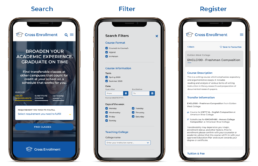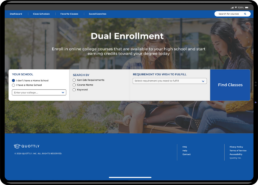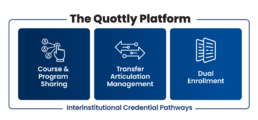Innovative Solutions for Institutional & Student Success
Quottly technology solutions help higher education systems, consortia, and institutions expand academic opportunity, create new pathways to completion, solve transfer challenges, and drive efficiency. Delivering three solutions powered by one technology platform, Quottly offers you the unique ability to integrate course and program sharing, transfer articulation, and dual enrollment initiatives to improve student and institutional success.
Course and Program Sharing
Expand Academic Opportunity & Help Students Succeed
Share courses and programs across systems, consortia, and institutions while providing students a seamless cross-registration experience, complete with real-time seat counts, course equivalencies, and degree pathways.

Transfer Articulation Management
Manage Course Equivalencies More Efficiently and Effectively
Create and manage course equivalencies more efficiently, automate articulation workflows, and help students see how the courses they take will count toward their academic pathways.

Dual Enrollment
Streamline Approvals, Enrollment, and Program Management
Simplify dual enrollment by managing course availability, automating approval workflows, and making it easy for high school students and counselors to find and register for dual-credit courses that are aligned with degree pathways.

Three Solutions, One Integrated Platform
Designed to improve student success while making your institution more efficient, the Quottly Platform is the only system that enables you to integrate course, program, transfer, and student data across initiatives and institutions.

Why 220+ Institutions Choose the Quottly Platform
- Fully Integrated Ecosystem
- Flexible Configuration
- Robust Administration
- Real-Time Reporting
- Seamless Student Experience
“Quottly helps remove administrative barriers facing students, allowing us to better meet students’ needs and facilitate degree completion.”
Dr. Gerry Hanley, California State University Long Beach